Urry D.W. (Ed.) What Sustains Life? : Consilient Mechanisms for Protein-Based Machines and Materials
Подождите немного. Документ загружается.

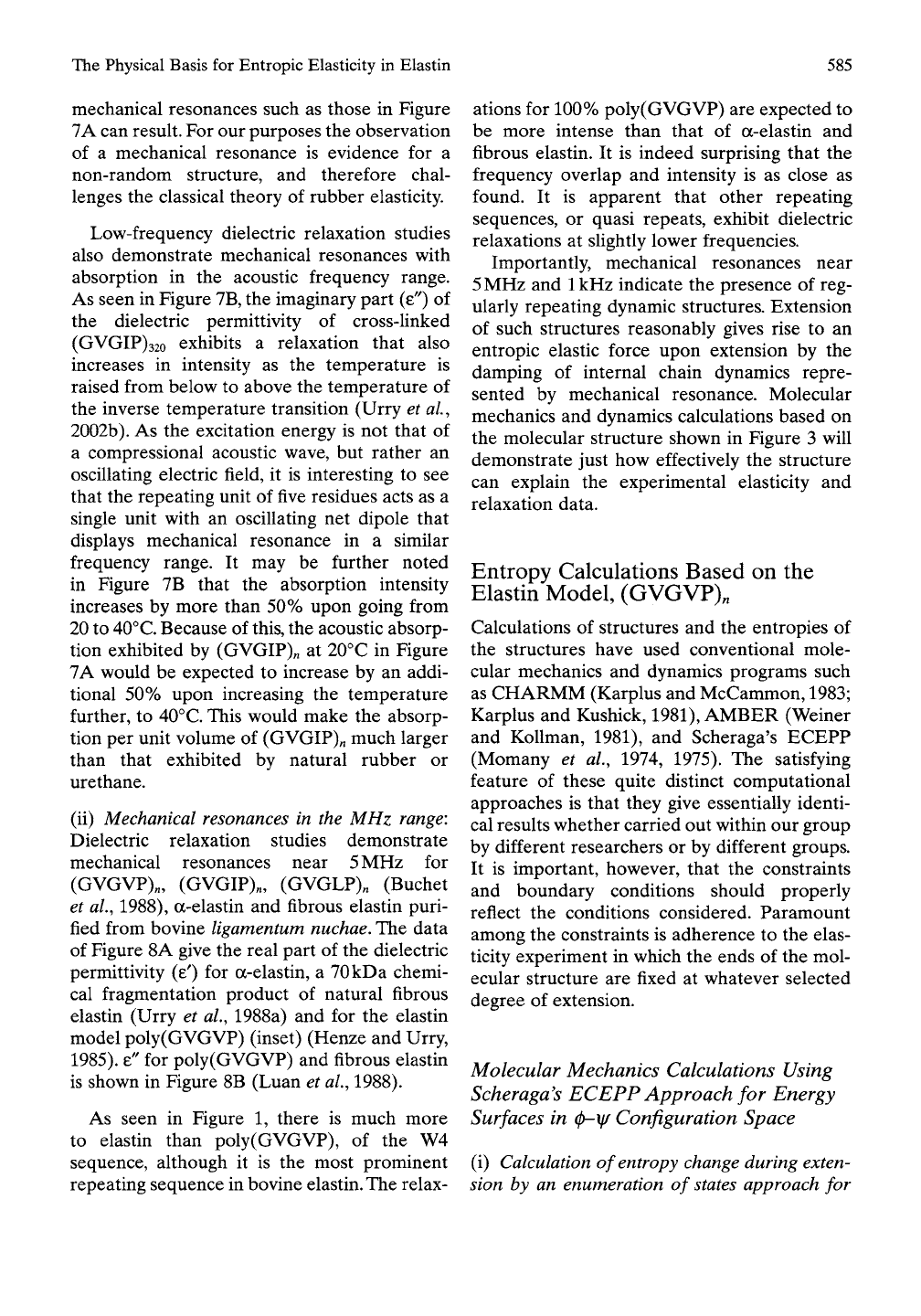
The Physical Basis for Entropic Elasticity in Elastin
585
mechanical resonances such as those in Figure
7A can result. For our purposes the observation
of a mechanical resonance is evidence for a
non-random structure, and therefore chal-
lenges the classical theory of rubber elasticity.
Low-frequency dielectric relaxation studies
also demonstrate mechanical resonances with
absorption in the acoustic frequency range.
As seen in Figure
7B,
the imaginary part (e") of
the dielectric permittivity of cross-linked
(GVGIP)32o exhibits a relaxation that also
increases in intensity as the temperature is
raised from below to above the temperature of
the inverse temperature transition (Urry et al,
2002b). As the excitation energy is not that of
a compressional acoustic wave, but rather an
oscillating electric field, it is interesting to see
that the repeating unit of five residues acts as a
single unit with an oscillating net dipole that
displays mechanical resonance in a similar
frequency range. It may be further noted
in Figure 7B that the absorption intensity
increases by more than 50% upon going from
20 to
40°C.
Because of
this,
the acoustic absorp-
tion exhibited by (GVGIP)„ at 20°C in Figure
7A would be expected to increase by an addi-
tional 50% upon increasing the temperature
further, to 40°C. This would make the absorp-
tion per unit volume of (GVGIP)„ much larger
than that exhibited by natural rubber or
urethane.
(ii) Mechanical resonances in the MHz range:
Dielectric relaxation studies demonstrate
mechanical resonances near
5
MHz for
(GVGVP)„, (GVGIP)„, (GVGLP)„ (Buchet
et al, 1988), a-elastin and fibrous elastin puri-
fied from bovine ligamentum
nuchae.
The data
of Figure 8A give the real part of the dielectric
permittivity (e') for a-elastin, a 70kDa chemi-
cal fragmentation product of natural fibrous
elastin (Urry et al, 1988a) and for the elastin
model poly(GVGVP) (inset) (Henze and Urry,
1985).
8" for poly(GVGVP) and fibrous elastin
is shown in Figure 8B (Luan et ai, 1988).
As seen in Figure 1, there is much more
to elastin than poly(GVGVP), of the W4
sequence, although it is the most prominent
repeating sequence in bovine
elastin.
The relax-
ations for 100% poly(GVGVP) are expected to
be more intense than that of a-elastin and
fibrous elastin. It is indeed surprising that the
frequency overlap and intensity is as close as
found. It is apparent that other repeating
sequences, or quasi repeats, exhibit dielectric
relaxations at shghtly lower frequencies.
Importantly, mechanical resonances near
5
MHz and
1
kHz indicate the presence of reg-
ularly repeating dynamic structures. Extension
of such structures reasonably gives rise to an
entropic elastic force upon extension by the
damping of internal chain dynamics repre-
sented by mechanical resonance. Molecular
mechanics and dynamics calculations based on
the molecular structure shown in Figure 3 will
demonstrate just how effectively the structure
can explain the experimental elasticity and
relaxation data.
Entropy Calculations Based on the
Elastin Model, (GVGVP),
Calculations of structures and the entropies of
the structures have used conventional mole-
cular mechanics and dynamics programs such
as CHARMM (Karplus and McCammon, 1983;
Karplus and Kushick, 1981), AMBER (Weiner
and KoUman, 1981), and Scheraga's ECEPP
(Momany et al., 1974, 1975). The satisfying
feature of these quite distinct computational
approaches is that they give essentially identi-
cal results whether carried out within our group
by different researchers or by different groups.
It is important, however, that the constraints
and boundary conditions should properly
reflect the conditions considered. Paramount
among the constraints is adherence to the elas-
ticity experiment in which the ends of the mol-
ecular structure are fixed at whatever selected
degree of extension.
Molecular Mechanics Calculations Using
Scheraga's ECEPP Approach for Energy
Surfaces in
(jy-y/
Configuration Space
(i)
Calculation
of entropy
change
during exten-
sion by an enumeration of
states
approach for

586
Mechanics
of
Elastin
Si30
o
s
80
30
5 a-elastin
JC^ ^^^
§*
b. 12.5£
o* c. 20 $140
,^'.s\v, f. 35 1
f^W v^^^ h 45
K^s^-.v"-
--^>,,
k. 60
<vn-5s-''cK^
1- 65
'--t^lKi^^^s^^^o
.»Poly(GVGVP) of elastin
\
\
_-..20'C
10
100 1000
Frequency (MHz)
10
100
Frequency (MHz)
1000
20
r
10
100
Frequency (MHz)
—r
1000
FIGURE
8.
Dielectric relaxation spectra
in the
1-1000
MHz frequency range of
a-
elastin (part
A), the
poly(GVGVP)
of
elastin (inset
of
part
A
and part B), and
fibrous elastin (part
B).
In all cases as the
temperature
is
raised there develops
an
intense mechanical relaxation centered
near
5
MHz
as
repeating elements
of
these protein systems hydrophobically
fold into regular, albeit obviously
dynamic, structures.
In the
case
of
poly(GVGVP) each pentamer folds into
the same conformation,
in
which
the
peptide moieties
(the
only entities with
dipole moments) undergo coordinated
rocking motions with
a
resulting oscil-
lating mean dipole moment. The rocking
of the mean dipole moments
of
the pen-
tamers resonate, in this case move, at the
same frequency
in
response
to an
alter-
nating electric field, that is, they exhibit
a mechanical resonance centered near
5
MHz.
A
similar mechanical resonance
is observed near
1
kHz
in
Figure 7. Part
A reproduced with permission from
Urry
et
al. (1988a),
and
part
B
repro-
duced with permission from Luan
et
al.
(1988).
relaxed
and
extended states:
In
Scheraga's
approach the internal energy
of a
chosen chain
segment
(in our
case
the
pentamer permuta-
tion, V1P2G3V4G5)
is
calculated
as a
function
of
a pair
of
adjacent torsion angles. Normally,
the
(|)
and \|/
torsion angles
are
identical
to
those
in
the Ramachandran plot.
In our
case since
the
primary sites
of
motion
are the
peptide moi-
eties
of
the suspended segment (V4G5V1), such
that the two (|)-\|/ plots, now called lambda plots,
become (t)5-\|/4
and
(t)i-\|/5.
In
the
enumeration
of
states approach,
a 5°
change
in a
single torsion angle
is
counted
as a
new state,
and the
number
of
states
is
counted
for
the
chosen cut-off energy
for
both
the
relaxed
and 130%
extended structures (Urry
et
a/., 1982;
Urry
and
Venkatachalam,
1983;
Urry
et al,
1985c; Urry, 1991).
A
single
pentamer
is
calculated within
the
relaxed
and
extended P-spiral structures,
and 0.6, 1.0 and
2.0kcal/mol-pentamer cut-off energies
are
used
as
well
as an
energy weighting using
the
Boltzmann summation over states. Table
1
gives
the
number
of
states where
the
entropy
is
simply calculated
by
Equation
(9)
using
the
example
of
1
kcal/mol-pentamer,
^S = (5^
- 50 =
Rln(W/W) = /?ln(58/762)
= -5.1 cal/mol-pentamer.
(9)
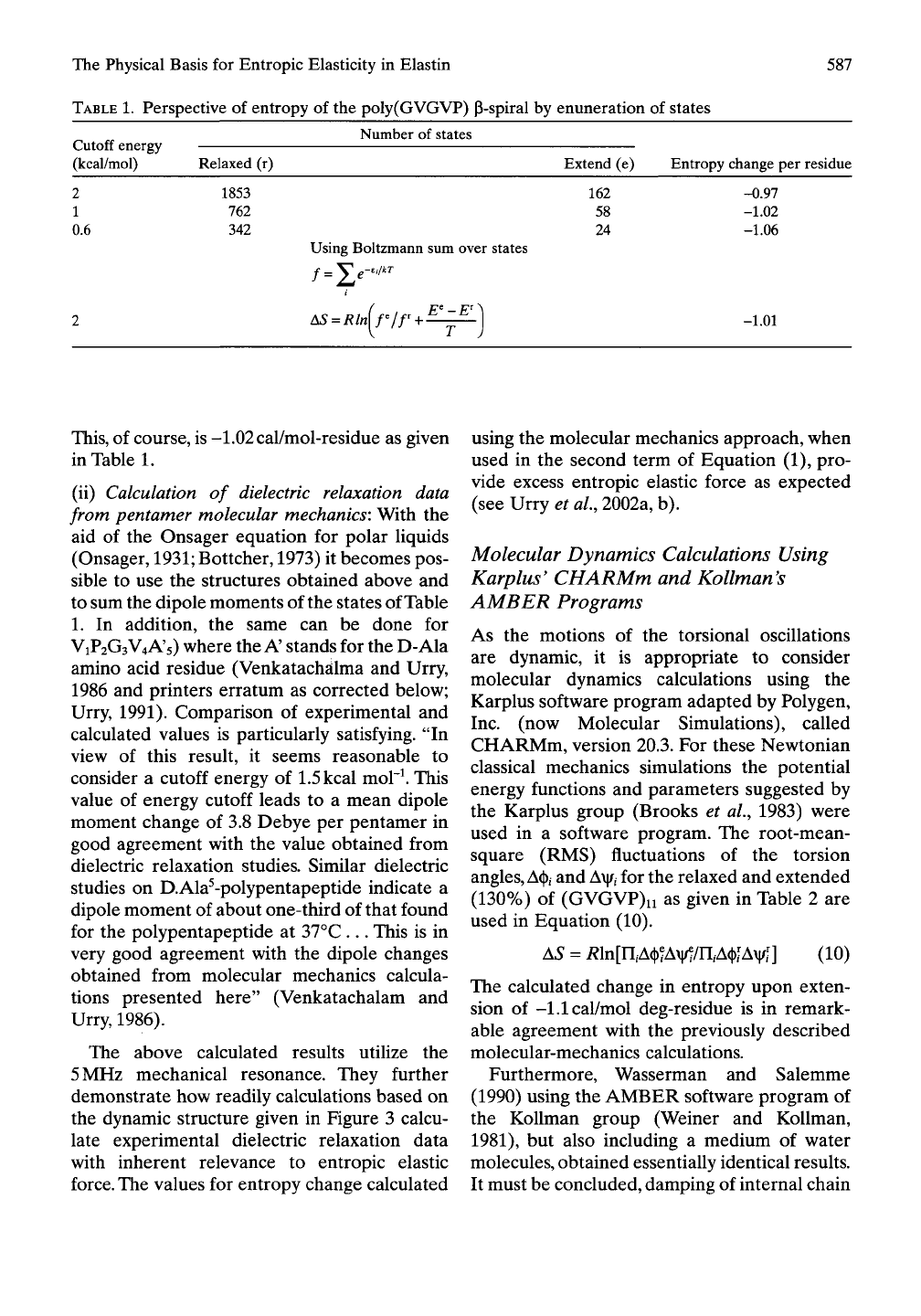
The Physical Basis for Entropic Elasticity in Elastin
TABLE
1. Perspective of entropy of the poly(GVGVP) P-spiral by enuneration of states
587
Cutoff energy
(kcal/mol)
2
1
0.6
2
Relaxed (r)
1853
762
342
Number of states
Using Boltzmann sum over states
AS=Rlnij'/r+ilj^^
Extend
162
58
24
(e)
Entropy change per residue
-0.97
-1.02
-1.06
-1.01
This,
of course, is -1.02cal/mol-residue as given
in Table 1.
(ii) Calculation of dielectric relaxation data
from pentamer molecular mechanics: With the
aid of the Onsager equation for polar liquids
(Onsager,
1931;
Bottcher, 1973) it becomes pos-
sible to use the structures obtained above and
to sum the dipole moments of the states of Table
1.
In addition, the same can be done for
ViP2G3V4A'5) where the A' stands for the D-Ala
amino acid residue (Venkatachdlma and Urry,
1986 and printers erratum as corrected below;
Urry, 1991). Comparison of experimental and
calculated values is particularly satisfying. "In
view of this result, it seems reasonable to
consider a cutoff energy of l.Skcal mol'^ This
value of energy cutoff leads to a mean dipole
moment change of 3.8 Debye per pentamer in
good agreement with the value obtained from
dielectric relaxation studies. Similar dielectric
studies on D.Ala^-polypentapeptide indicate a
dipole moment of about one-third of that found
for the polypentapeptide at 37°C ... This is in
very good agreement with the dipole changes
obtained from molecular mechanics calcula-
tions presented here" (Venkatachalam and
Urry, 1986).
The above calculated results utilize the
5 MHz mechanical resonance. They further
demonstrate how readily calculations based on
the dynamic structure given in Figure 3 calcu-
late experimental dielectric relaxation data
with inherent relevance to entropic elastic
force. The values for entropy change calculated
using the molecular mechanics approach, when
used in the second term of Equation (1), pro-
vide excess entropic elastic force as expected
(see Urry et al., 2002a, b).
Molecular Dynamics Calculations Using
Karplus' CHARMm and Kollman's
AMBER Programs
As the motions of the torsional oscillations
are dynamic, it is appropriate to consider
molecular dynamics calculations using the
Karplus software program adapted by Polygen,
Inc.
(now Molecular Simulations), called
CHARMm, version 20.3. For these Newtonian
classical mechanics simulations the potential
energy functions and parameters suggested by
the Karplus group (Brooks et al., 1983) were
used in a software program. The root-mean-
square (RMS) fluctuations of the torsion
angles,
Acj),
and A\|// for the relaxed and extended
(130%) of (GVGVP)n as given in Table 2 are
used in Equation (10).
AS = i?ln[n,A(|)?Av|/f/n4(|)fA\|/n (10)
The calculated change in entropy upon exten-
sion of -l.lcal/mol deg-residue is in remark-
able agreement with the previously described
molecular-mechanics calculations.
Furthermore, Wasserman and Salemme
(1990) using the AMBER software program of
the KoUman group (Weiner and KoUman,
1981),
but also including a medium of water
molecules, obtained essentially identical results.
It must be concluded, damping of internal chain

588
Mechanics of Elastin
TABLE
2.
RMS fluctuations of torsion angles (^ and \|/) of (VPGVG)ii (45 ps of equilibration time and 80 ps
of molecular dynamics simulation). Reproduced with permission from Chang and Urry (1989).
p-turns
Suspended
Segments
P-turns
Suspended
Segments
A5 =
/?/«—
Angle
Vl6
<t>17
Vl7
<|)18
Vi^l8
<t>19
Vl9
<|)20
V20
hi
V2I
<|)22
V22
<|>23
V|/23
<1)24
V24
<t>25
V|/25
<1)26
fA0[Av^[
*
Relaxed
10.87
09.86
47.59
61.70
09.37
14.25
44.09
41.94
14.50
27.13
09.39
09.94
11.58
16.37
14.33
11.39
19.53
25.02
49.32
31.43
Extended
14.17
15.18
46.68
47.41
16.05
08.67
10.99
09.29
11.15
24.17
22.73
08.00
16.13
09.33
14.25
29.20
37.87
23.06
32.10
27.24
Angle
V|/26
<1)27
V27
C|)28
^28
<t>29
V29
<t>30
Vi/30
<|>31
V|/31
<t>32
V|/32
h^
V33
<|)34
V34
<t>35
¥35
<t>36
Relaxed
27.33
11.71
11.70
08.61
09.33
09.70
47.32
48.57
42.56
11.43
12.17
09.90
15.30
09.60
09.88
11.86
63.80
91.70
15.03
21.49
Extended
07.64
08.33
13.51
10.36
08.16
07.31
10.48
11.39
10.62
11.38
09.21
08.93
10.80
07.62
09.43
09.71
08.36
10.20
11.51
18.66
Angle
V|/36
<|>37
VK37
<t>38
V38
^9
V39
<t>40
V40
<t)41
V|/41
^2
Vj/42
<|>43
V|/43
(|)44
\|/44
<t>45
^45
^6
Relaxed
20.19
08.99
21.53
11.15
11.09
12.70
52.00
55.88
40.67
36.44
12.97
11.59
11.34
09.23
10.60
11.06
41.89
48.98
42.05
21.55
Extended
14.84
10.47
32.96
10.66
27.29
10.24
12.50
08.37
11.08
19.06
14.80
07.33
13.17
09.76
12.53
12.82
35.22
31.31
56.89
30.33
dynamics is an abundant source of decrease in
chain entropy that is sufficient to account for
the entropic elastic force.
As Wasserman and Salemme (1990) included
water molecules in their calculations, and an
ordering of water molecules was found as the
hydrophobic side chains became exposed on
chain extension, they considered this decrease
in solvent entropy as a possible source of the
entropic elastic force. As will be shown below,
solvent entropy change does not make a
signif-
icant contribution to the entropic elastic force
development during isometric contractions.
Relationship Between
Hydrophobic
Association-Dissociation, Elastic
Force, and Energy Conversion in
Elastin Mechanics
By introducing glutamate (Gly, E) the ideal
elastomer in Figure 5A becomes a chemo-
mechanical transducer capable of converting
the chemical energy of proton concentration
changes into the mechanical energy of isotonic
and isometric contractions (See Figure 9A and
B).
An analysis of this data in combination with
that of Figure 6B resolves the issue of the role
of changes in solvent entropy in elastic force
development and energy conversion.
Chemically Driven Isotonic,
f 9L/3|Li//)/, and Isometric,
(3//3|I//)L5
Contractions
The elastin model protein of interest is poly[Xv-
(GVGVP),JCE(GEGVP)], where x^ and XE are
the mole fractions with
jCv
+
JCE
= 1 and for the
case where
JCE
= 0.2. Upon y-irradiation cross-
linking an elastic matrix is formed which can be
studied under isotonic and isometric condi-
tions.
Results are shown in Figure 9A and B
(Urry et al, 1988b). The isotonic contraction,
{dL/d[iH)f,
in Figure 9A is the change in length
at constant load (force) resulting from an
increase in the concentration of proton, that is,
the increase in chemical potential of proton
(3|i//)-
The isometric contraction,
(3//3|I//)L,
in
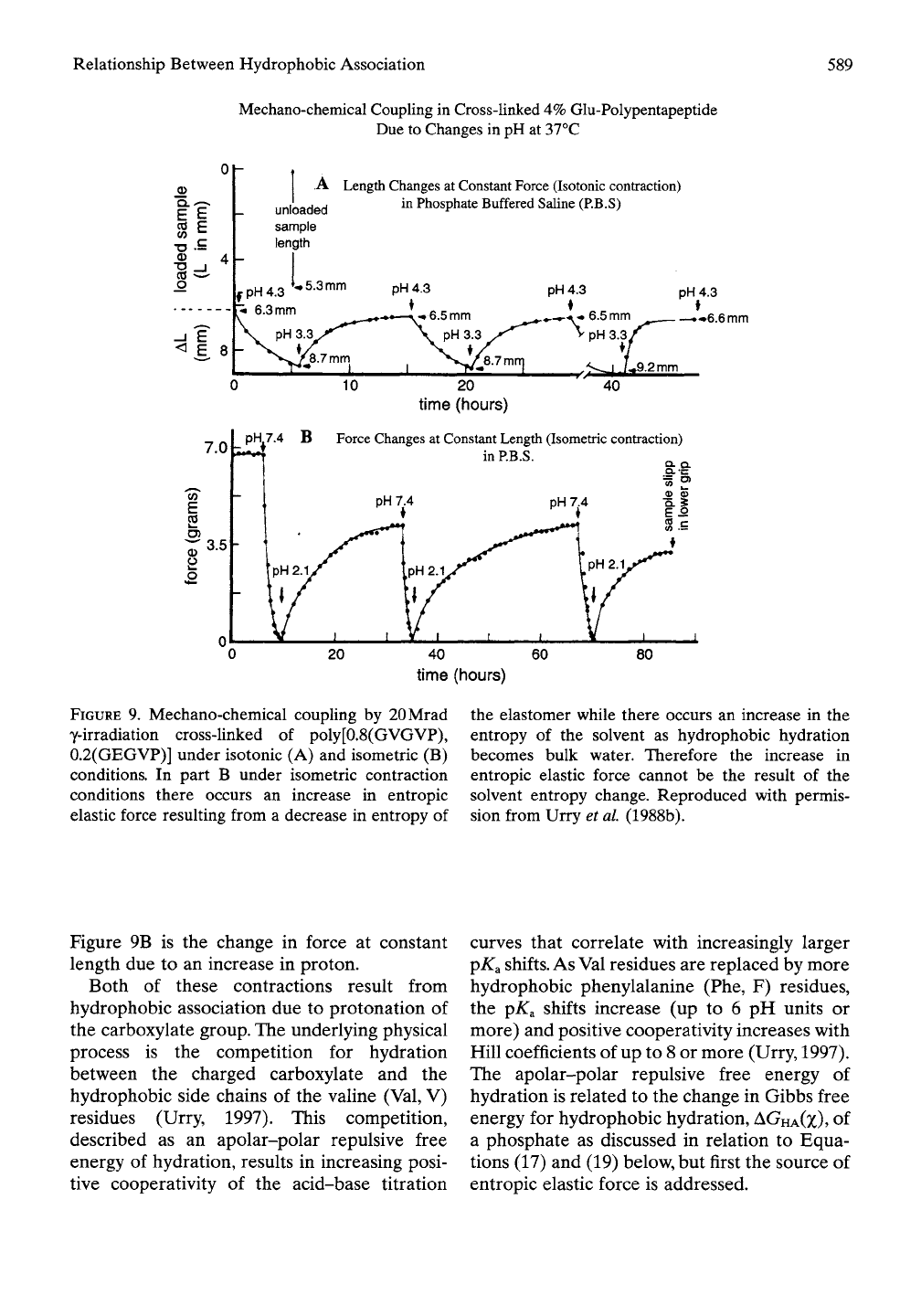
Relationship Between Hydrophobic Association
589
Mechano-chemical CoupUng in Cross-linked 4% Glu-Polypentapeptide
Due to Changes in pH at 37°C
if
0) 4
o
If
pH
4.3
6.3 mm
A Length Changes at Constant Force (Isotonic contraction)
unloaded
^"
Phosphate Buffered Saline (P.B.S)
sample
length
U 5.3 mm
pH
4.3
pH
4.3
pH
4.3
^•* 6.5
mm
^^^_^.^-^^ 6.5
mm
^ .^6.6 mm
pH 3.3 X'"'^
V pH
3.3;
•/ •/
^8.7 mm
20
time (hours)
\ L P'^i^-4 ^ Force Changes at Constant Length (Isometric contraction)
in P.B.S.
40
time (hours)
FIGURE 9. Mechano-chemical coupling by 20Mrad
y-irradiation cross-linked of poly[0.8(GVGVP),
0.2(GEGVP)] under isotonic (A) and isometric (B)
conditions. In part B under isometric contraction
conditions there occurs an increase in entropic
elastic force resulting from a decrease in entropy of
the elastomer while there occurs an increase in the
entropy of the solvent as hydrophobic hydration
becomes bulk water. Therefore the increase in
entropic elastic force cannot be the result of the
solvent entropy change. Reproduced with permis-
sion from Urry et al (1988b).
Figure 9B is the change in force at constant
length due to an increase in proton.
Both of these contractions result from
hydrophobic association due to protonation of
the carboxylate group. The underlying physical
process is the competition for hydration
between the charged carboxylate and the
hydrophobic side chains of the valine (Val, V)
residues (Urry, 1997). This competition,
described as an apolar-polar repulsive free
energy of hydration, results in increasing posi-
tive cooperativity of the acid-base titration
curves that correlate with increasingly larger
pA^a shifts. As Val residues are replaced by more
hydrophobic phenylalanine (Phe, F) residues,
the pA^a shifts increase (up to 6 pH units or
more) and positive cooperativity increases with
Hill coefficients of up to 8 or more (Urry, 1997).
The apolar-polar repulsive free energy of
hydration is related to the change in Gibbs free
energy for hydrophobic hydration, AGHA(5C), of
a phosphate as discussed in relation to Equa-
tions (17) and (19) below, but first the source of
entropic elastic force is addressed.
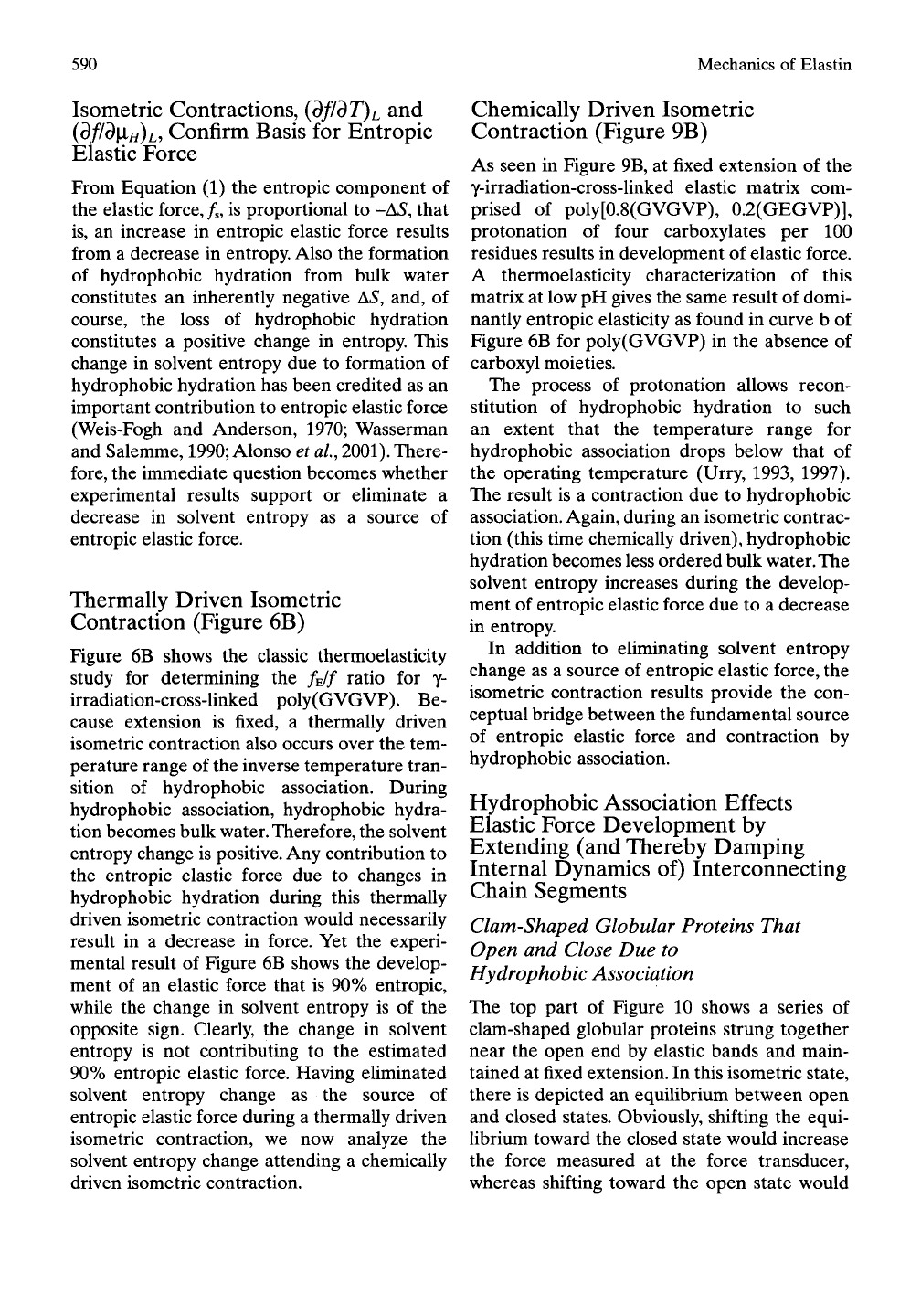
590
Mechanics
of Elastin
Isometric
Contractions,
(df/dT)L
and
(3//3|LI//)L,
Confirm Basis for Entropic
Elastic
Force
From Equation (1) the entropic component of
the elastic force,
/s,
is proportional to -A5, that
is,
an increase in entropic elastic force results
from a decrease in entropy. Also the formation
of hydrophobic hydration from bulk water
constitutes an inherently negative A^, and, of
course, the loss of hydrophobic hydration
constitutes a positive change in entropy. This
change in solvent entropy due to formation of
hydrophobic hydration has been credited as an
important contribution to entropic elastic force
(Weis-Fogh and Anderson, 1970; Wasserman
and Salemme,
1990;
Alonso et
aL,
2001).
There-
fore,
the immediate question becomes whether
experimental results support or eliminate a
decrease in solvent entropy as a source of
entropic elastic force.
Thermally
Driven Isometric
Contraction
(Figure 6B)
Figure 6B shows the classic thermoelasticity
study for determining the /E// ratio for y-
irradiation-cross-linked poly(GVGVP). Be-
cause extension is fixed, a thermally driven
isometric contraction also occurs over the tem-
perature range of the inverse temperature tran-
sition of hydrophobic association. During
hydrophobic association, hydrophobic hydra-
tion becomes bulk
water.
Therefore, the solvent
entropy change is
positive.
Any contribution to
the entropic elastic force due to changes in
hydrophobic hydration during this thermally
driven isometric contraction would necessarily
result in a decrease in force. Yet the experi-
mental result of Figure 6B shows the develop-
ment of an elastic force that is 90% entropic,
while the change in solvent entropy is of the
opposite sign. Clearly, the change in solvent
entropy is not contributing to the estimated
90%
entropic elastic force. Having eliminated
solvent entropy change as the source of
entropic elastic force during a thermally driven
isometric contraction, we now analyze the
solvent entropy change attending a chemically
driven isometric contraction.
Chemically
Driven Isometric
Contraction
(Figure 9B)
As seen in Figure 9B, at fixed extension of the
y-irradiation-cross-linked elastic matrix com-
prised of poly[0.8(GVGVP), 0.2(GEGVP)],
protonation of four carboxylates per 100
residues results in development of elastic force.
A thermoelasticity characterization of this
matrix at low pH gives the same result of domi-
nantly entropic elasticity as found in curve b of
Figure 6B for poly(GVGVP) in the absence of
carboxyl moieties.
The process of protonation allows recon-
stitution of hydrophobic hydration to such
an extent that the temperature range for
hydrophobic association drops below that of
the operating temperature (Urry, 1993, 1997).
The result is a contraction due to hydrophobic
association. Again, during an isometric contrac-
tion (this time chemically driven), hydrophobic
hydration becomes less ordered bulk water. The
solvent entropy increases during the develop-
ment of entropic elastic force due to a decrease
in entropy.
In addition to eliminating solvent entropy
change as a source of entropic elastic force, the
isometric contraction results provide the con-
ceptual bridge between the fundamental source
of entropic elastic force and contraction by
hydrophobic association.
Hydrophobic
Association Effects
Elastic
Force Development by
Extending
(and Thereby Damping
Internal
Dynamics of) Interconnecting
Chain
Segments
Clam-Shaped Globular Proteins That
Open and Close Due to
Hydrophobic Association
The top part of Figure 10 shows a series of
clam-shaped globular proteins strung together
near the open end by elastic bands and main-
tained at fixed extension. In this isometric state,
there is depicted an equilibrium between open
and closed states. Obviously, shifting the equi-
librium toward the closed state would increase
the force measured at the force transducer,
whereas shifting toward the open state would
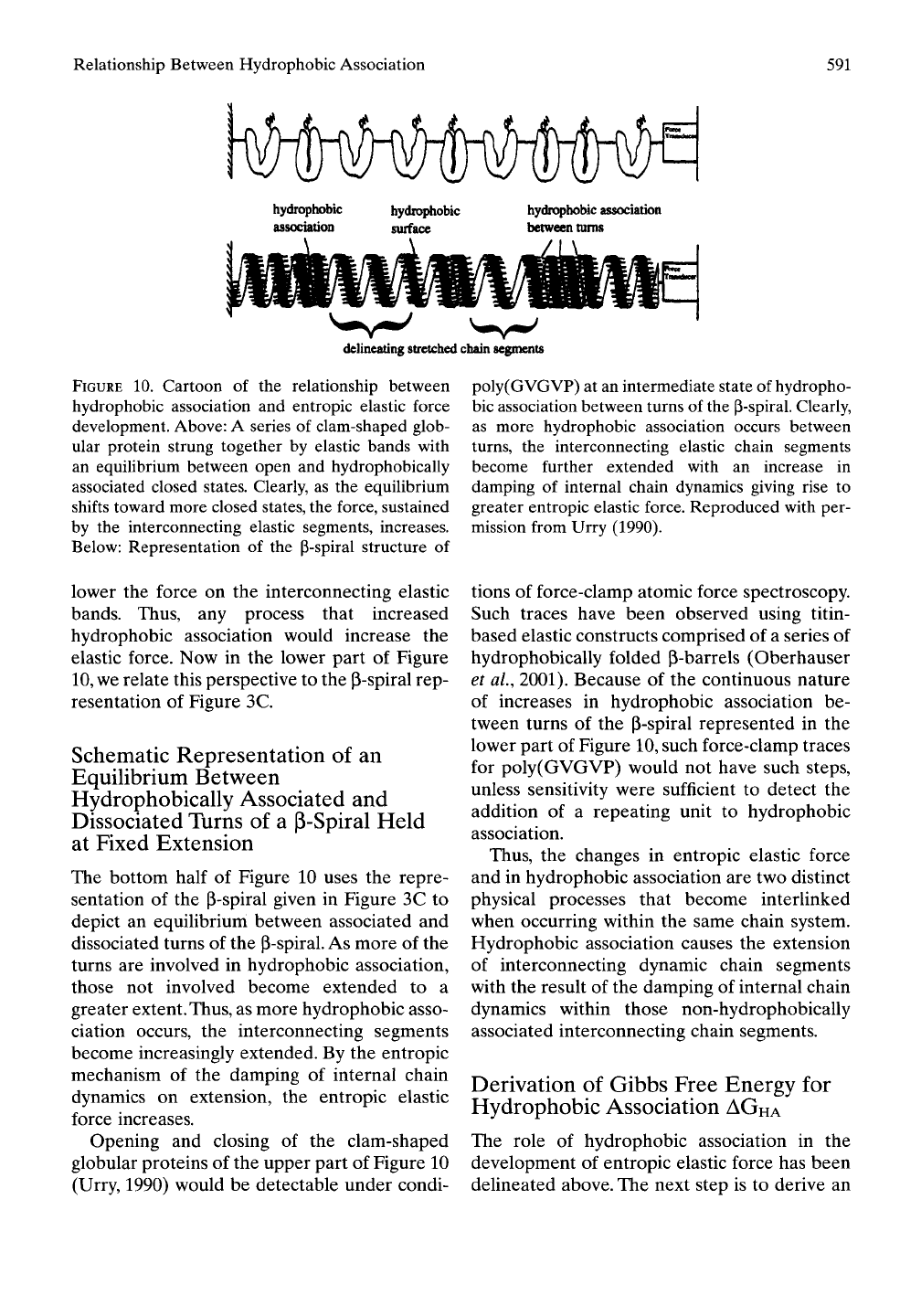
Relationship Between Hydrophobic Association
591
hydrophobic
association
hydrophobic
surface
hydrophobic
association
between
turns
delineating
stretched
chain segments
FIGURE 10. Cartoon of the relationship between
hydrophobic association and entropic elastic force
development. Above: A series of clam-shaped glob-
ular protein strung together by elastic bands with
an equilibrium between open and hydrophobically
associated closed states. Clearly, as the equilibrium
shifts toward more closed states, the force, sustained
by the interconnecting elastic segments, increases.
Below: Representation of the p-spiral structure of
lower the force on the interconnecting elastic
bands. Thus, any process that increased
hydrophobic association would increase the
elastic force. Now in the lower part of Figure
10,
we relate this perspective to the P-spiral rep-
resentation of Figure 3C.
Schematic Representation of an
Equilibrium Between
Hydrophobically Associated and
Dissociated Turns of a (3-Spiral Held
at Fixed Extension
The bottom half of Figure 10 uses the repre-
sentation of the p-spiral given in Figure 3C to
depict an equilibrium between associated and
dissociated turns of the p-spiral. As more of the
turns are involved in hydrophobic association,
those not involved become extended to a
greater extent.
Thus,
as more hydrophobic asso-
ciation occurs, the interconnecting segments
become increasingly extended. By the entropic
mechanism of the damping of internal chain
dynamics on extension, the entropic elastic
force increases.
Opening and closing of the clam-shaped
globular proteins of the upper part of Figure 10
(Urry, 1990) would be detectable under condi-
poly(GVGVP) at an intermediate state of hydropho-
bic association between turns of the p-spiral. Clearly,
as more hydrophobic association occurs between
turns,
the interconnecting elastic chain segments
become further extended with an increase in
damping of internal chain dynamics giving rise to
greater entropic elastic force. Reproduced with per-
mission from Urry (1990).
tions of force-clamp atomic force spectroscopy.
Such traces have been observed using titin-
based elastic constructs comprised of a series of
hydrophobically folded P-barrels (Oberhauser
et ai, 2001). Because of the continuous nature
of increases in hydrophobic association be-
tween turns of the P-spiral represented in the
lower part of Figure 10, such force-clamp traces
for poly(GVGVP) would not have such steps,
unless sensitivity were sufficient to detect the
addition of a repeating unit to hydrophobic
association.
Thus,
the changes in entropic elastic force
and in hydrophobic association are two distinct
physical processes that become interlinked
when occurring within the same chain system.
Hydrophobic association causes the extension
of interconnecting dynamic chain segments
with the result of the damping of internal chain
dynamics within those non-hydrophobically
associated interconnecting chain segments.
Derivation of Gibbs Free Energy for
Hydrophobic Association
AGRA
The role of hydrophobic association in the
development of entropic elastic force has been
delineated above. The next step is to derive an
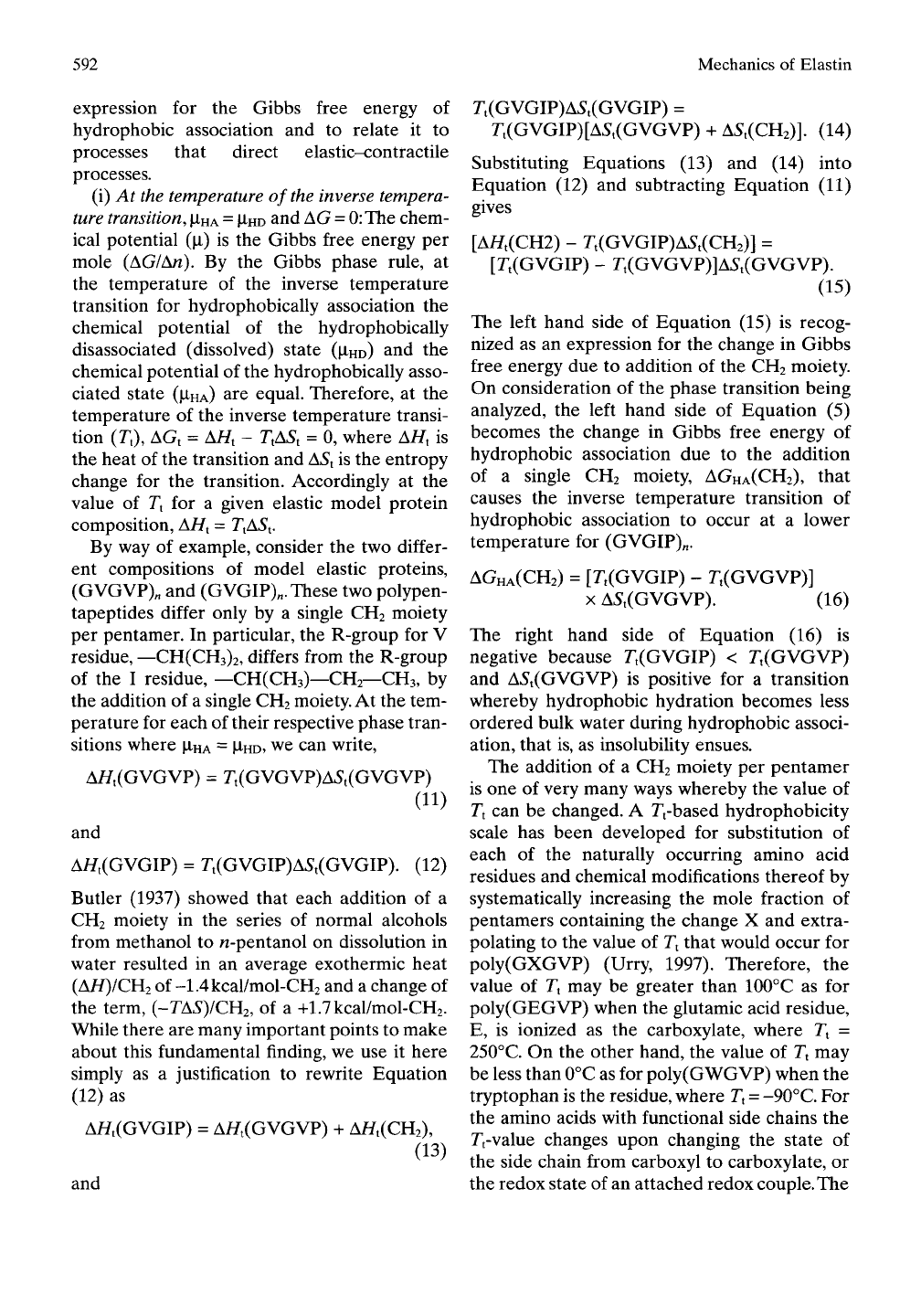
592 Mechanics of Elastin
expression for the Gibbs free energy of
hydrophobic association and to relate it to
processes that direct elastic-contractile
processes.
(i) At the temperature of the inverse tempera-
ture transition,
JLIHA
=
M^HD
and AG = 0: The chem-
ical potential (|i) is the Gibbs free energy per
mole (AG/A«). By the Gibbs phase rule, at
the temperature of the inverse temperature
transition for hydrophobically association the
chemical potential of the hydrophobically
disassociated (dissolved) state (|IHD) and the
chemical potential of the hydrophobically asso-
ciated state (|LIHA) are equal. Therefore, at the
temperature of the inverse temperature transi-
tion (Tt), AGt = A//t - T,^S, = 0, where ^H, is
the heat of the transition and AiSt is the entropy
change for the transition. Accordingly at the
value of Tt for a given elastic model protein
composition. A/ft =
T^/S^S^.
By way of example, consider the two differ-
ent compositions of model elastic proteins,
(GVGVP)„ and (GVGIP)^. These two polypen-
tapeptides differ only by a single CH2 moiety
per pentamer. In particular, the R-group for V
residue, —CH(CH3)2, differs from the R-group
of the I residue, —CH(CH3)—CH2—CH3, by
the addition of a single CH2 moiety. At the tem-
perature for each of their respective phase tran-
sitions where
|IHA
=
M^HD,
we can write,
Ai/t(GVGVP) = rt(GVGVP)A5t(GVGVP)
(11)
and
A//t(GVGIP) = Tt(GVGIP)A5t(GVGIP). (12)
Butler (1937) showed that each addition of a
CH2 moiety in the series of normal alcohols
from methanol to n-pentanol on dissolution in
water resulted in an average exothermic heat
(A//)/CH2 of -1.4kcal/mol-CH2 and a change of
the term, (-rA5)/CH2, of a +1.7kcal/mol-CH2.
While there are many important points to make
about this fundamental finding, we use it here
simply as a justification to rewrite Equation
(12) as
A//t(GVGIP) = A//t(GVGVP) + A//t(CH2),
(13)
and
rt(GVGIP)AS,(GVGIP) =
rt(GVGIP)[A5,(GVGVP) + AStCCHz)]. (14)
Substituting Equations (13) and (14) into
Equation (12) and subtracting Equation (11)
gives
[A//,(CH2) - r,(GVGIP)A5,(CH2)] =
[r,(GVGIP) - r,(GVGVP)]A5t(GVGVP).
(15)
The left hand side of Equation (15) is recog-
nized as an expression for the change in Gibbs
free energy due to addition of the CH2 moiety.
On consideration of the phase transition being
analyzed, the left hand side of Equation (5)
becomes the change in Gibbs free energy of
hydrophobic association due to the addition
of a single CH2 moiety, AGHA(CH2), that
causes the inverse temperature transition of
hydrophobic association to occur at a lower
temperature for (GVGIP)„.
AGHA(CH2) = [rt(GVGIP) - rt(GVGVP)]
X
A5t(GVGVP). (16)
The right hand side of Equation (16) is
negative because rt(GVGIP) < rt(GVGVP)
and A5t(GVGVP) is positive for a transition
whereby hydrophobic hydration becomes less
ordered bulk water during hydrophobic associ-
ation, that is, as insolubility ensues.
The addition of a CH2 moiety per pentamer
is one of very many ways whereby the value of
Tt can be changed. A Tt-based hydrophobicity
scale has been developed for substitution of
each of the naturally occurring amino acid
residues and chemical modifications thereof by
systematically increasing the mole fraction of
pentamers containing the change X and extra-
polating to the value of
T^
that would occur for
poly(GXGVP) (Urry, 1997). Therefore, the
value of Tt may be greater than 100°C as for
poly(GEGVP) when the glutamic acid residue,
E, is ionized as the carboxylate, where T^ =
250°C. On the other hand, the value of
T^
may
be less than 0°C as for poly(GWGVP) when the
tryptophan is the residue, where Tt = -90°C. For
the amino acids with functional side chains the
TfValue changes upon changing the state of
the side chain from carboxyl to carboxylate, or
the redox state of an attached redox
couple.
The
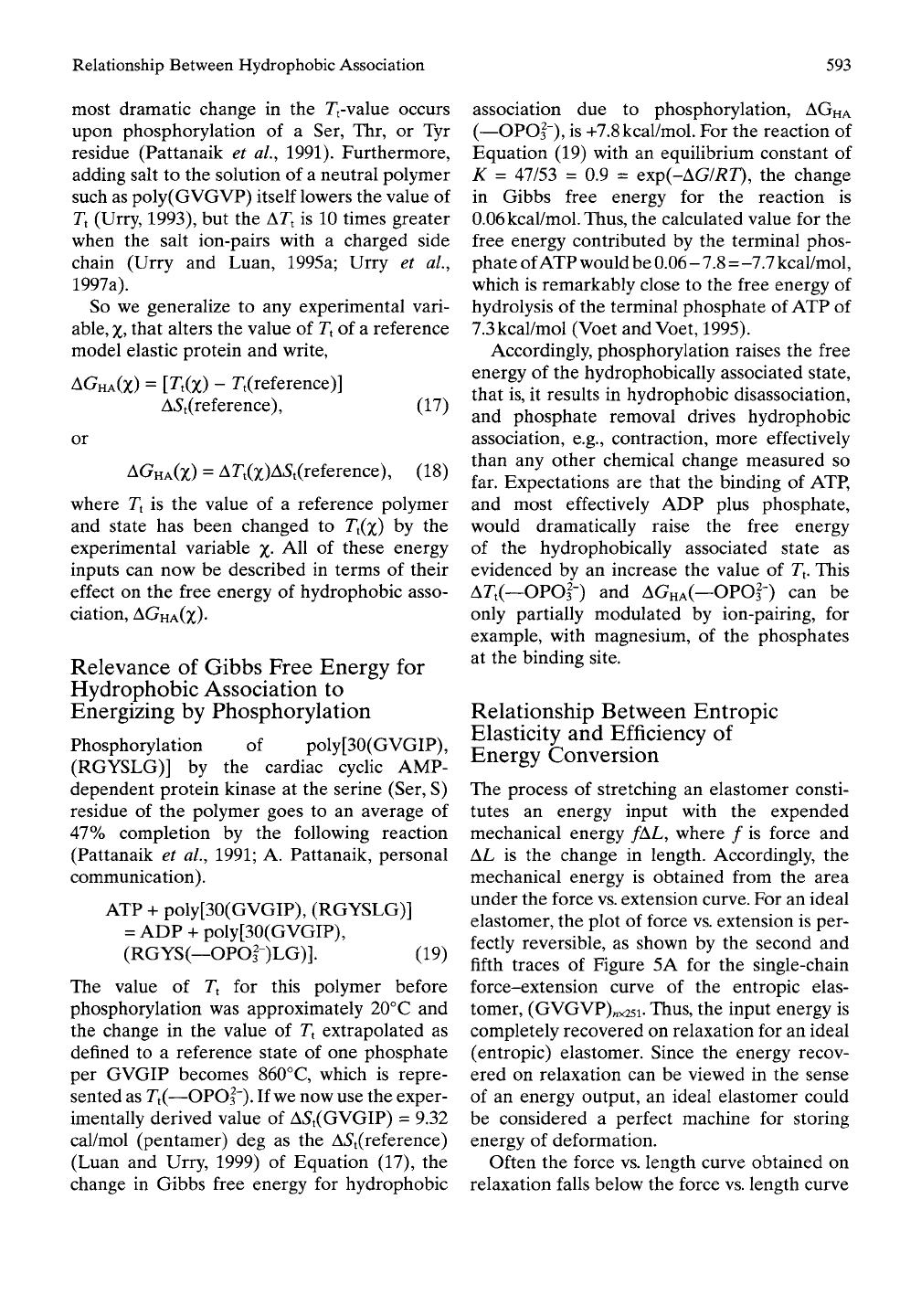
Relationship Between Hydrophobic Association
593
most dramatic change
in the
Tt-value occurs
upon phosphorylation
of a Ser, Thr, or Tyr
residue (Pattanaik
et aL,
1991). Furthermore,
adding salt
to the
solution
of a
neutral polymer
such
as
poly(GVGVP) itself lowers
the
value
of
Tt (Urry, 1993),
but the A^t is 10
times greater
when
the
salt ion-pairs with
a
charged side
chain (Urry
and
Luan, 1995a; Urry
et al,
1997a).
So
we
generalize
to any
experimental vari-
able,
X,
that alters
the
value
of
71
of a
reference
model elastic protein
and
write,
AGHA(Z)
= [Ux) - rt(reference)]
A5t(reference),
(17)
or
AGHA(X)
= Ar,(x)A5t(reference), (18)
where
Tt is the
value
of a
reference polymer
and state
has
been changed
to Tt(x) by the
experimental variable
%. All of
these energy
inputs
can now be
described
in
terms
of
their
effect
on the
free energy
of
hydrophobic asso-
ciation,
AGHA(Z).
Relevance
of
Gibbs Free Energy
for
Hydrophobic Association
to
Energizing
by
Phosphorylation
Phosphorylation
of
poly[30(GVGIP),
(RGYSLG)]
by the
cardiac cyclic
AMP-
dependent protein kinase
at the
serine (Ser,
S)
residue
of the
polymer goes
to an
average
of
47%
completion
by the
following reaction
(Pattanaik
et al,
1991;
A.
Pattanaik, personal
communication).
ATP -h poly[30(GVGIP), (RGYSLG)]
= ADP
-H
poly[30(GVGIP),
(RGYS(—OPO|-)LG)].
(19)
The value
of T^ for
this polymer before
phosphorylation
was
approximately 20° C
and
the change
in the
value
of
T^ extrapolated
as
defined
to a
reference state
of one
phosphate
per GVGIP becomes 860°C, which
is
repre-
sented as 7't(—OPO3").
If
we now use the exper-
imentally derived value
of
A5t(GVGIP)
= 9.32
cal/mol (pentamer)
deg as the
A5t(reference)
(Luan
and
Urry,
1999) of
Equation
(17), the
change
in
Gibbs free energy
for
hydrophobic
association due to phosphorylation,
AGHA
(—OPOl"),
is
+7.8kcal/mol.
For the
reaction
of
Equation
(19)
with
an
equilibrium constant
of
K
=
47/53
= 0.9 =
exp(-AG/RT),
the
change
in Gibbs free energy
for the
reaction
is
0.06kcal/mol. Thus,
the
calculated value
for the
free energy contributed
by the
terminal phos-
phate of ATP would be 0.06
-
7.8=-7.7 kcal/mol,
which
is
remarkably close
to the
free energy
of
hydrolysis
of
the terminal phosphate
of
ATP
of
7.3 kcal/mol (Voet and Voet, 1995).
Accordingly, phosphorylation raises
the
free
energy
of the
hydrophobically associated state,
that is,
it
results
in
hydrophobic disassociation,
and phosphate removal drives hydrophobic
association,
e.g.,
contraction, more effectively
than
any
other chemical change measured
so
far. Expectations
are
that
the
binding
of
ATP,
and most effectively
ADP
plus phosphate,
would dramatically raise
the
free energy
of
the
hydrophobically associated state
as
evidenced
by an
increase
the
value
of
Tt. This
ATti—OFOi)
and
AGHA(—OPOl")
can be
only partially modulated
by
ion-pairing,
for
example, with magnesium,
of the
phosphates
at
the
binding site.
Relationship Between Entropic
Elasticity
and
Efficiency
of
Energy Conversion
The process
of
stretching
an
elastomer consti-
tutes
an
energy input with
the
expended
mechanical energy /AL, where
/ is
force
and
AL
is the
change
in
length. Accordingly,
the
mechanical energy
is
obtained from
the
area
under the force vs. extension curve. For
an
ideal
elastomer, the plot
of
force vs. extension
is
per-
fectly reversible,
as
shown
by the
second
and
fifth traces
of
Figure
5A for the
single-chain
force-extension curve
of the
entropic elas-
tomer, (GVGVP)„x25i. Thus,
the
input energy
is
completely recovered
on
relaxation
for an
ideal
(entropic) elastomer. Since
the
energy recov-
ered
on
relaxation
can be
viewed
in the
sense
of
an
energy output,
an
ideal elastomer could
be considered
a
perfect machine
for
storing
energy
of
deformation.
Often
the
force vs. length curve obtained
on
relaxation falls below
the
force vs. length curve
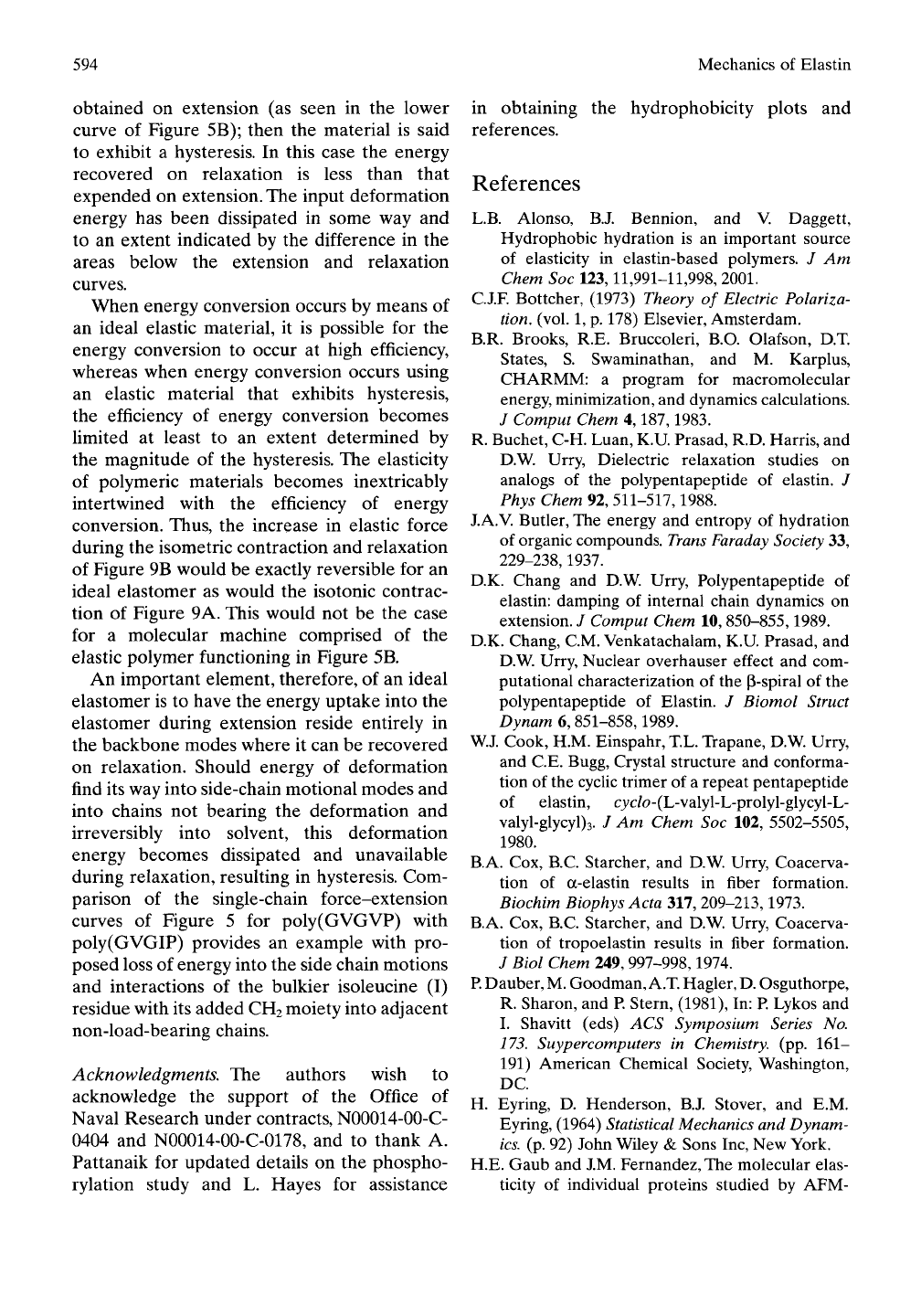
594 Mechanics of Elastin
obtained on extension (as seen in the lower
curve of Figure 5B); then the material is said
to exhibit a hysteresis. In this case the energy
recovered on relaxation is less than that
expended on extension. The input deformation
energy has been dissipated in some way and
to an extent indicated by the difference in the
areas below the extension and relaxation
curves.
When energy conversion occurs by means of
an ideal elastic material, it is possible for the
energy conversion to occur at high efficiency,
whereas when energy conversion occurs using
an elastic material that exhibits hysteresis,
the efficiency of energy conversion becomes
limited at least to an extent determined by
the magnitude of the hysteresis. The elasticity
of polymeric materials becomes inextricably
intertwined with the efficiency of energy
conversion. Thus, the increase in elastic force
during the isometric contraction and relaxation
of Figure 9B would be exactly reversible for an
ideal elastomer as would the isotonic contrac-
tion of Figure 9A. This would not be the case
for a molecular machine comprised of the
elastic polymer functioning in Figure 5B.
An important element, therefore, of an ideal
elastomer is to have the energy uptake into the
elastomer during extension reside entirely in
the backbone modes where it can be recovered
on relaxation. Should energy of deformation
find its way into side-chain motional modes and
into chains not bearing the deformation and
irreversibly into solvent, this deformation
energy becomes dissipated and unavailable
during relaxation, resulting in hysteresis. Com-
parison of the single-chain force-extension
curves of Figure 5 for poly(GVGVP) with
poly(GVGIP) provides an example with pro-
posed loss of energy into the side chain motions
and interactions of the bulkier isoleucine (I)
residue with its added CH2 moiety into adjacent
non-load-bearing chains.
Acknowledgments. The authors wish to
acknowledge the support of the Office of
Naval Research under contracts, N00014-00-C-
0404 and N00014-00-C-0178, and to thank A.
Pattanaik for updated details on the phospho-
rylation study and L. Hayes for assistance
in obtaining the hydrophobicity plots and
references.
References
L.B.
Alonso, B.J. Bennion, and V. Daggett,
Hydrophobic hydration is an important source
of elasticity in elastin-based polymers. / Am
Chem Soc 123,11,991-11,998,
2001.
C.J.F. Bottcher, (1973) Theory of
Electric
Polariza-
tion,
(vol. 1,
p.
178) Elsevier, Amsterdam.
B.R. Brooks, R.E. Bruccoleri, B.O. Olafson, D.T.
States, S. Swaminathan, and M. Karplus,
CHARMM: a program for macromolecular
energy, minimization, and dynamics calculations.
/ Comput Chem 4,187,1983.
R. Buchet, C-H. Luan, K.U. Prasad, R.D. Harris, and
D.W. Urry, Dielectric relaxation studies on
analogs of the polypentapeptide of elastin. /
Phys Chem 92, 511-517,1988.
J.A.V. Butler, The energy and entropy of hydration
of organic compounds.
Trans Faraday
Society 33,
229-238,1937.
D.K. Chang and D.W. Urry, Polypentapeptide of
elastin: damping of internal chain dynamics on
extension. / Comput Chem 10, 850-855,1989.
D.K. Chang, CM. Venkatachalam, K.U. Prasad, and
D.W. Urry, Nuclear overhauser effect and com-
putational characterization of the p-spiral of the
polypentapeptide of Elastin. / Biomol Struct
Dynam 6, 851-858,1989.
W.J. Cook, H.M. Einspahr, T.L. Trapane, D.W. Urry,
and C.E. Bugg, Crystal structure and conforma-
tion of the cyclic trimer of a repeat pentapeptide
of elastin, cyc/o-(L-valyl-L-prolyl-glycyl-L-
valyl-glycyl)3.
/ Am Chem Soc 102, 5502-5505,
1980.
B.A. Cox, B.C. Starcher, and D.W. Urry, Coacerva-
tion of a-elastin results in fiber formation.
Biochim Biophys Acta 317, 209-213,1973.
B.A. Cox, B.C. Starcher, and D.W. Urry, Coacerva-
tion of tropoelastin results in fiber formation.
/ Biol Chem 249, 997-998,1974.
P.
Dauber,
M.
Goodman,
A.T.
Hagler,
D.
Osguthorpe,
R. Sharon, and R Stern, (1981), In: R Lykos and
I. Shavitt (eds) ACS Symposium Series No.
173.
Suypercomputers in Chemistry, (pp. 161-
191) American Chemical Society, Washington,
DC.
H. Eyring, D. Henderson, B.J. Stover, and E.M.
Eyring, (1964)
Statistical Mechanics
and Dynam-
ics,
(p. 92) John Wiley & Sons Inc, New York.
H.E. Gaub and J.M. Fernandez, The molecular elas-
ticity of individual proteins studied by AFM-
